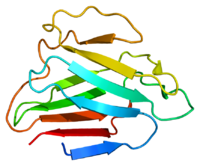
Photo from wikipedia
We propose a simple model for chromatin organization based on the interaction of the chromatin fibers with lamin proteins along the nuclear membrane. Lamin proteins are known to be a… Click to show full abstract
We propose a simple model for chromatin organization based on the interaction of the chromatin fibers with lamin proteins along the nuclear membrane. Lamin proteins are known to be a major factor that influences chromatin organization and hence gene expression in the cells. We provide a quantitative understanding of lamin-associated chromatin organization in a crowded macromolecular environment by systematically varying the heteropolymer segment distribution and the strength of the lamin-chromatin attractive interaction. Our minimal polymer model reproduces the formation of lamin-associated-domains and provides an in silico tool for quantifying domain length distributions for different distributions of heteropolymer segments. We show that a Gaussian distribution of heteropolymer segments, coupled with strong lamin-chromatin interactions, can qualitatively reproduce observed length distributions of lamin-associated-domains. Further, lamin-mediated interaction can enhance the formation of chromosome territories as well as the organization of chromatin into tightly packed heterochromatin and the loosely packed gene-rich euchromatin regions.
Journal Title: Biophysical journal
Year Published: 2020
Link to full text (if available)
Share on Social Media: Sign Up to like & get
recommendations!